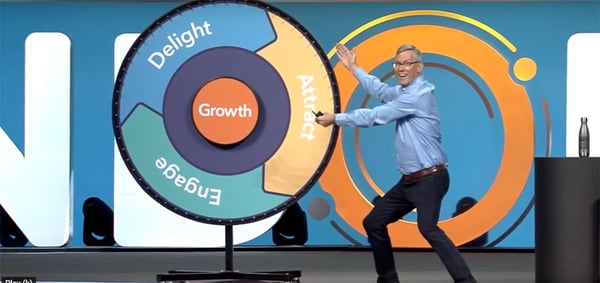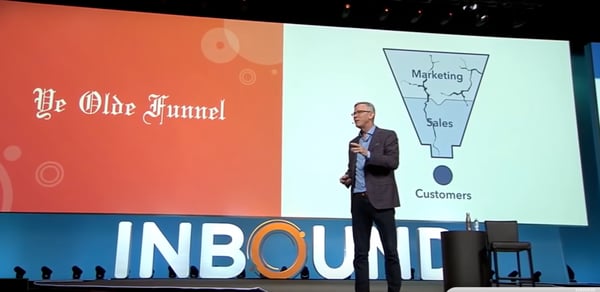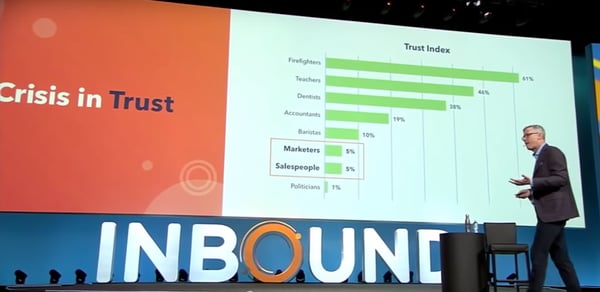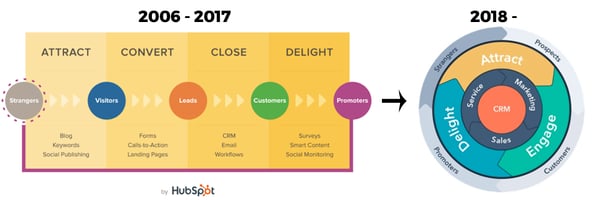In the opening keynote at Inbound 2018, Brian Halligan threw "Ye Olde Funnel" a retirement party and introduced his bright new replacement, the HubSpot Flywheel.
Was that replacement premature?
We'll argue yes, but we'll also show why HubSpot's embrace of the flywheel metaphor (which Halligan says he borrowed from Jeff Bezos) has some merit. It does help us understand some of the concepts that the funnel doesn't. And the ideas that it helps us visualize are more important than ever.
So, it's worth a look. Whether you embrace the flywheel or not, the concepts behind Halligan's colorful wheel are crucial in 2019.
But is the model strong enough to replace Ye Olde Funnel?
For reasons we'll outline below, the flywheel may stand alongside the funnel as a useful model. But, in its current state, the flywheel won't replace the funnel.
website grader
Is Your HubSpot Setup Costing You Deals?
Enter your URL for a customized Conversion Kit that identifies key setup improvements, highlights missed opportunities, and provides recommendations to maximize your HubSpot ROI.
- Audit your HubSpot setup for conversion efficiency
- Uncover missed opportunities to capture more leads
- See tailored recommendations to improve site speed and usability
Thanks for submitting the form!
Why The HubSpot Flywheel Won't Replace the Funnel
First, it's important to note what Halligan is trying to help us understand when he talks about this flywheel-for-funnel replacement. "I've come up with a whole new model for describing how you grow."
He's looking for a new growth model to fit some changes he perceives in the landscape.
Halligan's switch to the flywheel in 2018 was prompted by what he says was a shift over the last couple of years in the way buyers make purchase decisions. These changes revealed what he calls cracks in the funnel, and prompted him to seek a new metaphor.
Let's take a look at the two problems Halligan has with Ye Olde Funnel and then analyze his solution.
Funnel Crack #1: Customers Are an Output
Halligan introduces the first crack by sharing anecdotal evidence of "a crisis of trust" in sales and marketing through his regular interviews with HubSpot customers. For 10 years, Halligan says, customers said they first heard about HubSpot by subscribing to their blog, then talking to a sales rep. "That tells me that inbound marketing is working as advertised. Marketing and Sales are in your head when you're making a decision."
But, that "loudest voice" has changed over the last two years.
Halligan says that HubSpot customers now talk about industry referrals as the first way that they encounter the company. Word of mouth is now the loudest voice in their head.
Halligan then moves from anecdotal evidence to third-party validation of this shift by showing how low sales and marketing rank in the Trust Index—right above politicians.
"Who do people trust?" Halligan asks. "They trust your customers ... The first crack in the funnel is that customers are shown as an output when we all know that customers are actually an input to your business in today's day and age."
Funnel Crack #2: Quarter to Quarter Momentum
Halligan spends much less time on crack #2. He mentions that a former boss used to say that "The sun rises and sets on the quarter," meaning that sales and marketing would wring every ounce of value from their pipelines at the end of the quarter and start over again the next quarter.
But, he says, we've gotten so good at inbound marketing that we now have quarter-to-quarter momentum and don't have to start from scratch every three months. Our pipelines stay full because of the assets we've created which automatically bring prospects to us.
My Take on the Two Cracks
I think Halligan's ability to perceive and react to shifts in the market is what has made him an extremely successful CEO. And, his method of explaining these somewhat abstract ideas by using metaphors, like cracks in a funnel and retirement parties, is what makes him a fantastic communicator.
But, I don't think the changes he's referring to are necessarily as dramatic as he says they are. He didn't drive this point home with enough data.
The obvious question that comes to mind when Halligan illustrates the "loudest voice" shift from sales and marketing to word of mouth by anecdotal evidence is, do we have a fundamental landscape shift on our hands or is this change a byproduct of HubSpot's growth? It seems logical that as a company grows to the size of HubSpot, there would naturally be a shift in the way that people first hear about the company.
The problem with Halligan's brief Trust Index data splash is that it doesn't show a shift. It just shows us a single snapshot. So, it's not clear that there has been an erosion of trust in sales and marketing. We marketers may have never been more trusted than we are today.
So, I don't think he made a strong enough argument for this monumental change in customer behavior to warrant a wholesale reversal in the way we understand the customer journey.
I do think he's right that things have changed in inbound marketing over the last couple of years. (We've had several internal discussions about this at Lean Labs.) For instance, because so many companies have gone all-in on inbound marketing, it is taking a little more time to see the results from organic rankings.
Does blogging for SEO still work? Absolutely. In our view, it still delivers the best bang for your buck, by far, for deserving brands to grow their companies. (Learn more about how we help 10x deserving brands here.)
But it takes a little more time and effort than it used to. There's a lot more content out there than there was when HubSpot launched over a decade ago.
Halligan is referring to when he talks about the second crack and quarter to quarter momentum. Yes, we're good at keeping the funnel full, but that doesn't mean the funnel metaphor is inadequate for the job it's trying to do.
It was never intended to show how people got into it. The funnel is an illustration of the customer journey.
When you don't have a lot of customers, you can't count on them to generate more customers by referral. So, you have to have a funnel first to get the great brand advocates that Halligan says have broken the funnel in his first point. And, you have to build the funnel first before you can get to the quarter to quarter momentum that has created the second crack.
So, I don't think we need to kick Ye Olde Funnel out of the workforce quite yet.
Now let's take a look at the young upstart who is trying to send the funnel packing.
HubSpot's Flywheel
Before we look at Halligan's explanation of the new HubSpot flywheel, let's look at how the company has transitioned pieces of its old (funnel on its side) model into the new form.
The are two major changes. The first is that they've moved from a linear format to circular (obvious). The second change is that they've collapsed the middle stages. The Convert and Close steps have been combined into Engage, and Visitors and Leads have been merged into Prospects.
On stage, Halligan doesn't show the old model or mention these name changes. He wheels out the new, high-level flywheel (less detailed than above) and talks about how it takes care of the first two issues which the funnel couldn't solve.
"First, it has our happy customers on there, and it's a circle. They're inputs to our new customers. The second thing I like about it is that it doesn't just give us credit for what's going on in a given month or quarter, it's got all of our leads, all of our customers, all of our promoters on it. It's got a sense of leverage and momentum."
3 Flywheel Growth Tips
Halligan then gives us three flywheel growth tips which we can leverage to make the flywheel spin faster to grow our businesses.
1. Apply Force
Where should you apply force to get the biggest ROI? He says that the highest return was the Engage stage (sales) from 1990 - 2006. Then, when customers gained access to the same info as salespeople from 2006 - 2018, you got the biggest return from the Attract stage. So, marketers created as much content as possible to pull people into that. And in 2018, as he illustrated with his first funnel crack point, the biggest return is in the Delight stage where word of mouth wins. So, we should apply force in that area, but not just in the Service department. Sales and marketing should be focused on Customer Delight as well.
2. Lower Friction
The less friction you have in a flywheel, the faster it spins. Halligan says companies are lowering friction by moving from full-service to self-service, from 9-to-5 to 24-x-7, and from buy-first to try-first. "It used to be, the best product won. Now, it's the best customer experience wins. It used to be what you sold. Now, it's how you sell it." Halligan then moves through three tips for removing friction from the customer experience.
3. Use Scalable Material
A flywheel has to be durable to withstand the force of high speeds. In this third point, Halligan goes into a bit of a sales pitch for HubSpot by showing how they have recently filled out the Sales and Service Hubs to give us a full flywheel of tools. He also mentions that HubSpot is now offering Enterprise products for all three stages that will grow with companies, indicating that they can serve a broader range of company sizes.
FREE GUIDE
Get The HubSpot Onboarding Guide.
Set your team up for success on HubSpot with frictionless onboarding. You’ll learn about:
- Initial HubSpot setup
- Lead management
- Process automation
- Success planning
Thanks for submitting the form!
Other HubSpot Flywheel Resources
Halligan's keynote was the launch of the flywheel metaphor in the HubSpot ecosystem. They've since produced a few resources which clarify and expand on some of the points from the kickoff keynote.
The Flywheel pillar page follows the same flow as Halligan's keynote, with three videos from the HubSpot management team explaining some of the basic concepts. Here are a couple of quotes from the pillar page which reveal a little more about how the flywheel and funnel concepts compare.
Because they’re linear, funnels don’t reveal the momentum you build through a great product and customer experience, nor the drag you experience when your processes start to slow down growth.
Our flywheels represent a circular process where customers feed growth. We’ve invested more in customer marketing, more in customer advocacy, and more in creating delightful onboarding for new customers.
Here we see a little more about how HubSpot is using the flywheel in their own company. "Customer marketing" and "customer advocacy" are not terms you hear a lot in the inbound marketing space, but I think we'll hear more of it in the future, from HubSpot at least.
HubSpot also put together a very short (2 videos) course on the flywheel in their HubSpot Academy. The second video in the course takes a different approach to the relationship between the funnel and the flywheel. It's titled "Combining Funnels and Flywheels." Notice that the company is now walking back their "replacement" stance by "combining" the funnel and flywheel. They're admitting that the funnel isn't quite as retired as Halligan suggested in the keynote, even within the walls of their offices in Boston.
By taking the individual funnels within your business and positioning them inside the larger flywheel, you'll unlock all kinds of opportunities for cross-team collaboration. You'll be able to optimize, not just individual conversion rates, but also the activities that happen long before an individual interaction that will impact how that interaction goes. With your entire company thinking about accelerating the flywheel as a whole, rather than just improving their individual funnel metrics, you'll be able to make improvements that would have otherwise been impossible.
In several places throughout these additional content pieces, HubSpotters talk about how prepping for the Delight stage during the Attract and Engage stages will help develop promoters when the time comes. They talk a lot about setting expectations with their prospects so that they're fully satisfied as customers.
Strengths and Weaknesses of the Flywheel
For metaphors like the funnel and flywheel to be helpful, they have to be useful to marketers on a daily basis. In other words, how do the models help marketing and sales teams stay focused on the right things and measure them as they execute campaigns?
The HubSpot team is touching on this value when they talk about cross-team collaboration (reducing friction) and expectation setting (customer prepping).
I think there is value in connecting marketing, sales, and service, and the flywheel does this better than the funnel. When silos are broken down inside a company, the journey is certainly more friction-less and enjoyable for the customer. And, if you can keep that friction-is-the-enemy idea in mind every time you see a flywheel, that can help focus the team's attention on the full customer experience, rather than their own KPIs and individual goals.
The flywheel is weak, however, when it comes to attaching real metrics and initiatives to it. Momentum and friction are what the flywheel illustrates best, but how do you actually measure these growth factors? And, if you can measure them, where do you put them on the flywheel?
Halligan and company maintain that the funnel fails because it's linear when it should be circular. But the customer journey is, in fact, linear, which is why the funnel works in the first place. The customer only goes through each stage once (for the most part). So, a top-to-bottom flow where the numbers get smaller as you go makes sense. Advantage funnel.
The flywheel is also weak because it's complex. Complexity is the enemy when you're trying to visualize abstract concepts. The simpler, the better. But, with four layers of concentric circles which separate at different points, it isn't clear how one circle affects the other. It makes me dizzy.
They Haven't Nailed It Yet
I love a good conceptual metaphor, and I think the flywheel has potential. But it's not there yet for me.
If HubSpot wants to convince the marketing world to replace the funnel with the flywheel, they need to do three things.
- Give their claims that there's been a substantial shift in consumer behavior more traction with real third party data. Prove to us that there's been a big change with actual numbers. Then we'll be more ready to embrace a new model.
- Make the flywheel less conceptual and more actionable. Give us more real-life examples of the flywheel in action.
- Connect the concentric circles a little more. Do a better job of conceptually showing us how they work together to influence growth.
Until then, we'll hold off on throwing a retirement party for Ye Olde Funnel.









